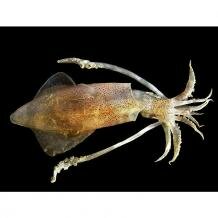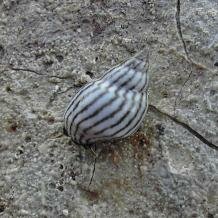Topic: Camera eyes in vertebrates, cephalopods and other animals
Camera eyes are superb optical devices, so it is not surprising that they have evolved several times. But why, of all animals, in the brainless jellyfish? Or for that matter in a slow-moving snail?
Camera eyes are a type of simple eye, where light is received through a single opening (in contrast to compound eyes, where light enters through multiple openings).  As the name suggests, a camera eye is built in the form of two chambers separated by a lens that projects an inverted image onto the light-sensitive retina. Naturally, the lens has to be transparent, and this is achieved by using crystallin proteins (which represent a compelling example of molecular convergence). To form a sharp image, the lens must focus the light precisely on the retina. The snag is that the degree of refraction (i.e. how much the light is bent as it moves from one medium to another, as described in Snell’s Law) in a spherical lens depends on the light path taken. Uncorrected this leads to spherical aberration and hence an unfocused image on the retina. The remedy is to alter the refractive index of the lens systematically from the centre to the margin, and several groups have independently arrived at this solution. Quite often, the amount of light entering the lens is controlled by a pupil (equivalent to a shutter). In large camera eyes, nearby objects are imaged further away from the lens than distant objects, so a mechanism of accommodation is needed. Most terrestrial animals change the shape of the lens (and the cornea is also involved in focussing), while aquatic animals move the lens.
As the name suggests, a camera eye is built in the form of two chambers separated by a lens that projects an inverted image onto the light-sensitive retina. Naturally, the lens has to be transparent, and this is achieved by using crystallin proteins (which represent a compelling example of molecular convergence). To form a sharp image, the lens must focus the light precisely on the retina. The snag is that the degree of refraction (i.e. how much the light is bent as it moves from one medium to another, as described in Snell’s Law) in a spherical lens depends on the light path taken. Uncorrected this leads to spherical aberration and hence an unfocused image on the retina. The remedy is to alter the refractive index of the lens systematically from the centre to the margin, and several groups have independently arrived at this solution. Quite often, the amount of light entering the lens is controlled by a pupil (equivalent to a shutter). In large camera eyes, nearby objects are imaged further away from the lens than distant objects, so a mechanism of accommodation is needed. Most terrestrial animals change the shape of the lens (and the cornea is also involved in focussing), while aquatic animals move the lens.
Camera eyes have superb optical properties, combining high resolution with high light-gathering power. The camera eye is the standard eye type of vertebrates (which, accordingly, show a large repertoire of visually guided behaviours), but has evolved independently in a number of other groups.
Cephalopods
 The camera eyes of cephalopods such as octopuses, squid and cuttlefish are celebrated for their remarkable parallels with those of vertebrates. This convergence does not only include structural similarity of the optical apparatus, but extends to extra-ocular muscles moving the eyeball, a pupil controlling the incidence of light and a lens correcting for spherical aberration in the same way. However, there are some differences between vertebrate and cephalopod camera eyes, for example concerning developmental processes and the focussing mechanism. Cephalopods show further interesting eye-related convergences with respect to polarisation vision and lateralised eye use (as well as sleep).
The camera eyes of cephalopods such as octopuses, squid and cuttlefish are celebrated for their remarkable parallels with those of vertebrates. This convergence does not only include structural similarity of the optical apparatus, but extends to extra-ocular muscles moving the eyeball, a pupil controlling the incidence of light and a lens correcting for spherical aberration in the same way. However, there are some differences between vertebrate and cephalopod camera eyes, for example concerning developmental processes and the focussing mechanism. Cephalopods show further interesting eye-related convergences with respect to polarisation vision and lateralised eye use (as well as sleep).
Gastropods
 Cephalopods are not the only molluscs with camera eyes. Within the snails, this type of eye has evolved independently at least four times (which at first sight might be a little unexpected, as the need for well-developed eyes in these usually slow-moving creatures is not immediately obvious). The pelagic heteropods are active carnivores with large camera eyes that probably possess vertebrate-like acuity. However, the retina is in the form of a narrow ribbon, so the eye is quickly rotated to provide a scanning motion (which has evolved independently in jumping spiders, the larvae of diving beetles and some crustaceans). Also a variety of bottom-dwelling snails, including the strombids, the pulmonates and the littorinids, have camera eyes of considerable sophistication, and their function might involve the detection of predators or the identification of vertical structures to escape predation or to reach the water surface for breathing.
Cephalopods are not the only molluscs with camera eyes. Within the snails, this type of eye has evolved independently at least four times (which at first sight might be a little unexpected, as the need for well-developed eyes in these usually slow-moving creatures is not immediately obvious). The pelagic heteropods are active carnivores with large camera eyes that probably possess vertebrate-like acuity. However, the retina is in the form of a narrow ribbon, so the eye is quickly rotated to provide a scanning motion (which has evolved independently in jumping spiders, the larvae of diving beetles and some crustaceans). Also a variety of bottom-dwelling snails, including the strombids, the pulmonates and the littorinids, have camera eyes of considerable sophistication, and their function might involve the detection of predators or the identification of vertical structures to escape predation or to reach the water surface for breathing.
Annelids
Camera eyes are furthermore found in one group of annelid worms, the alciopids. This is not so surprising when one takes into account that these pelagic polychaetes are active predators. The similarity to the vertebrate eye has attracted considerable comment, and the eye structure includes a spherical lens, a retina (which, unlike in vertebrates, is everted) and a double-layered cornea. Alciopids furthermore possess a so-called accessory retina that might help capture the limited amount of light penetrating to depth. This type of retina is also found in a number of deep-sea fish and cephalopods.
Cubozoans
 Probably the most unlikely owners of camera eyes are the cubozoan jellyfish. Being cnidarians, they have no real equivalent to a brain, let alone an optic lobe. However, cubozoans are extraordinary in a number of respects and often labelled “honorary fish”. As they are surprisingly fast-moving and agile predators, it had been assumed that their camera eyes are used in hunting. They are located on the rhopalia, club-like extensions near the base of the bell, and each rhopalium possesses an upwards-pointing and a downwards-pointing camera eye. Both are built on the standard pattern, with a lens that corrects almost perfectly for spherical aberration, and the lower eye also possesses an iris. Strangely enough, however, the point of focus lies well behind the retina, meaning that these well-designed eyes produce a blurred image. It has been suggested that this might be an adaptation to allow the animal to navigate safely amongst rootlets of mangroves and find the sunlit areas where their prey congregates without constant distractions. Further yet unsolved puzzles of cubozoan vision include where the visual information is processed and why the rhopalia also accommodate two pairs of simpler eyes in addition to the camera eyes.
Probably the most unlikely owners of camera eyes are the cubozoan jellyfish. Being cnidarians, they have no real equivalent to a brain, let alone an optic lobe. However, cubozoans are extraordinary in a number of respects and often labelled “honorary fish”. As they are surprisingly fast-moving and agile predators, it had been assumed that their camera eyes are used in hunting. They are located on the rhopalia, club-like extensions near the base of the bell, and each rhopalium possesses an upwards-pointing and a downwards-pointing camera eye. Both are built on the standard pattern, with a lens that corrects almost perfectly for spherical aberration, and the lower eye also possesses an iris. Strangely enough, however, the point of focus lies well behind the retina, meaning that these well-designed eyes produce a blurred image. It has been suggested that this might be an adaptation to allow the animal to navigate safely amongst rootlets of mangroves and find the sunlit areas where their prey congregates without constant distractions. Further yet unsolved puzzles of cubozoan vision include where the visual information is processed and why the rhopalia also accommodate two pairs of simpler eyes in addition to the camera eyes.
Cite this web page
Map of Life - "Camera eyes in vertebrates, cephalopods and other animals"
https://mapoflife.org/topics/topic_1_camera-eyes-in-vertebrates-cephalopods-and-other-animals/
April 25, 2021

